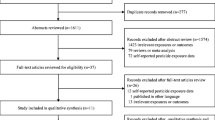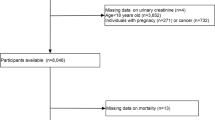Abstract
Except the known risk factors for hypertension, several studies have suggested that exposure to persistent organic pollutants (POPs), endocrine disrupting chemicals, could be associated with an increased risk of hypertension. In this study, we performed a meta-analysis to summarize the existing epidemiological studies to investigate the association between POPs concentration and risk of hypertension. Based on comprehensive literature search results (PubMed, EMBASE, and KoreaMed), a meta-analysis of 11 articles was performed using a random-effects model. While we observed no significant association between the sum of non-dioxin-like PCBs and the risk of hypertension (OR = 1.00; 95 % CI 0.89, 1.12), the sum of dioxin-like PCBs was associated with a significantly increased risk of hypertension (OR = 1.45; 95 % CI 1.00, 2.12). High p,p′-DDE level was also significantly associated with the increased risk of hypertension. When subgroup analyses were carried out for studies which analyzed POPs concentrations using high-resolution gas chromatography/high-resolution mass spectrometry, the overall pooled estimate ORs increased with decreased heterogeneity, providing it as a possible heterogeneity source (OR = 1.36; 95 % CI 1.21, 1.52; I 2 = 42.8 %; p = 0.045). This study suggested that the concentration of certain POPs, especially dioxin-related compounds, was associated with the risk of hypertension.


Similar content being viewed by others
References
Akishita M, Fukai S, Hashimoto M, Kameyama Y, Nomura K, Nakamura T et al (2010) Association of low testosterone with metabolic syndrome and its components in middle-aged Japanese men. Hypertens Res 33(6):587–591
Andersson H, Garscha U, Brittebo E (2011) Effects of PCB126 and 17beta-oestradiol on endothelium-derived vasoactive factors in human endothelial cells. Toxicology 285(1–2):46–56
Arrebola JP, Fernández MF, Martin-Olmedo P, Bonde JP, Martín-Rodriguez JL, Expósito J, Rubio-Domínguez A, Olea N (2015) Historical exposure to persistent organic pollutants and risk of incident hypertension. Environ Res 138:217–223
Begg CB, Mazumdar M (1994) Operating characteristics of a rank correlation test for publication bias. Biometrics 50:1088–1101
Blanco-Muñoz J, Lacasaña M, Aguilar-Garduño C, Rodríguez-Barranco M, Bassol S, Cebrián ME et al (2012) Effect of exposure to p, p’-DDE on male hormone profile in Mexican flower growers. Occup Environ Med 69(1):5–11
Cook NR, Cutler JA, Obarzanek E, Buring JE, Rexrode KM, Kumanyika SK et al (2007) Long term effects of dietary sodium reduction on cardiovascular disease outcomes: observational follow-up of the trials of hypertension prevention (TOHP). BMJ 334(7599):885–888
Daston GP, Cook JC, Kavlock RJ (2003) Uncertainties for endocrine disrupters: our view on progress. Toxicol Sci 74(2):245–252
DerSimonian R, Laird N (1986) Meta-analysis in clinical trials. Control Clin Trials 7(3):177–188
Egger M, Davey Smith G, Schneider M, Minder C (1997) Bias in metaanalysis detected by a simple, graphical test. BMJ 315:629–634
Everett CJ, Mainous AG 3rd, Frithsen IL, Player MS, Matheson EM (2008) Association of polychlorinated biphenyls with hypertension in the 1999–2002 National Health and Nutrition Examination Survey. Environ Res 108(1):94–97
Gao H, Yang BJ, Li N, Feng LM, Shi XY, Zhao WH, Liu SJ (2015) Bisphenol A and hormone-associated cancers: current progress and perspectives. Medicine (Baltimore) 94(1), E211
Goncharov A, Bloom M, Pavuk M, Birman I, Carpenter DO (2010) Blood pressure and hypertension in relation to levels of serum polychlorinated biphenyls in residents of Anniston, Alabama. J Hypertens 28(10):2053–2060
Goncharov A, Pavuk M, Foushee HR, Carpenter DO (2011) Blood pressure in relation to concentrations of PCB congeners and chlorinated pesticides. Environ Health Perspect 119(3):319–325
Gus M, Fuchs SC, Moreira LB, Moraes RS, Wiehe M, Silva AF et al (2004) Association between different measurements of obesity and the incidence of hypertension. Am J Hypertens 17:50–53
Ha MH, Lee DH, Son HK, Jacobs DR Jr (2009) Association between serum concentrations of persistent organic pollutants and prevalence of newly diagnosed hypertension: results from the National Health and Nutrition Examination Survey 1999–2002. J Hum Hypertens 23(4):274–286
Henríquez-Hernández LA, Luzardo OP, Zumbado M, Camacho M, Serra-Majem L, Álvarez-León EE, Boada LD (2014) Blood pressure in relation to contamination by polychlorobiphenyls and organochlorine pesticides: results from a population-based study in the Canary Islands (Spain). Environ Res 135:48–54
Higgins JPT, Green S (2011) Cochrane handbook for systematic reviews of interventions, version 5.1.0. http://www.cochranehandbook.org. Accessed 20 Mar 2015
Higgins JP, Thompson SG, Deeks JJ, Altman DG (2003) Measuring inconsistency in meta-analyses. BMJ 327(7414):557–560
İlhan S, Ateşşahin D, Ateşşahin A, Mutlu E, Onat E, Sahna E (2015) 2,3,7,8-Tetrachlorodibenzo-p-dioxin-induced hypertension: the beneficial effects of melatonin. Toxicol Ind Health 31(4):298–303
Iszatt N, Stigum H, Verner MA, White RA, Govarts E, Palkovicova Murinova L et al (2015) Prenatal and postnatal exposure to persistent organic pollutants and infant growth: a pooled analysis of seven European birth cohorts. Environ Health Perspect 123(7):730–736
Judd NL, Griffith WC, Kalman DA, Faustman EM (2003) Assessment of PCB congener analytical methods Do they meet risk assessment needs? Arch Environ Contam Toxicol 44(1):132–139
Karlaganis G, Marioni R, Sieber I, Weber A (2001) The elaboration of the 'Stockholm convention' on persistent organic pollutants (POPs): a negotiation process fraught with obstacles and opportunities. Environ Sci Pollut Res Int 8(3):216–221
Kramer S, Hikel SM, Adams K, Hinds D, Moon K (2012) Current Status of the Epidemiologic Evidence Linking Polychlorinated Biphenyls and Non-Hodgkin Lymphoma, and the Role of Immune Dysregulation. Environ Health Perspect 120:1067–1075
Kreiss K, Zack MM, Kimbrough RD, Needham LL, Smrek AL, Jones BT (1981) Association of blood pressure and polychlorinated biphenyl levels. JAMA 245(24):2505–2509
Lee DH, Lee IK, Porta M, Steffes M, Jacobs DR Jr (2007) Relationship between serum concentrations of persistent organic pollutants and the prevalence of metabolic syndrome among non-diabetic adults: results from the National Health and Nutrition Examination Survey 1999–2002. Diabetologia 50(9):1841–1851
Lee DH, Porta M, Jacobs DR Jr, Vandenberg LN (2014) Chlorinated persistent organic pollutants, obesity, and type 2 diabetes. Endocr Rev 35(4):557–601
Lin CY, Chen PC, Kuo HK, Lin LY, Lin JW, Hwang JJ (2009) Effects of obesity, physical activity, and cardiorespiratory fitness on blood pressure, inflammation, and insulin resistance in the National Health and Nutrition Survey 1999–2002. Nutr Metab Cardiovasc Dis 20(10):713–719
Lind PM, Penell J, Salihovic S, van Bavel B, Lind L (2014) Circulating levels of p, p’-DDE are related to prevalent hypertension in the elderly. Environ Res 129:27–31
Longnecker MP, Korrick SA, Moysich KB (2003) Dioxins and Health, 2nd edn. John Wiley & Sons, Inc., New Jersey, pp 679–728
Nakamoto M, Arisawa K, Uemura H, Katsuura S, Takami H, Sawachika F et al (2013) Association between blood levels of PCDDs/PCDFs/dioxin-like PCBs and history of allergic and other diseases in the Japanese population. Int Arch Occup Environ Health 86(8):849–859
Nwankwo T, Yoon SS, Burt V, Gu Q (2013) Hypertension among adults in the United States: National Health and Nutrition Examination Survey, 2011–2012. NCHS Data Brief 133:1–138
Rushton L (2003) Health hazards and waste management. Br Med Bull 68:183–197
Shankar A, Klein R, Klein BE et al (2006) The association between serum uric acid level and long-term incidence of hypertension: population-based cohort study. J Hum Hypertens 20(12):937–945
Smarr MM, Grantz KL, Zhang C, Sundaram R, Maisog JM, Barr DB, Louis GM (2016) Persistent organic pollutants and pregnancy complications. Sci Total Environ 551–552:285–291
Steenland K, Tinker S, Shankar A et al (2010) Association of perfluorooctanoic acid (PFOA) and perfluorooctane sulfonate (PFOS) with uric acid among adults with elevated community exposure to PFOA. Environ Health Perspect 118(2):229–333
Svartberg J, Jenssen T, Sundsfjord J, Jorde R (2004) The associations of endogenous testosterone and sex hormone-binding globulin with glycosylated hemoglobin levels, in community dwelling men. The Tromsø Study. Diabetes Metab 30(1):29–34
U.S. EPA (Environmental Protection Agency) (1994) Method 1613, Tetra-through Octa-Chlorinated Dioxins and Furans by Isotope Dilution HRGC/HRMS. http://www.well-labs.com/docs/epa%20method%201613_oct1994.pdf. Accessed 12 Jan 2016
U.S. EPA (Environmental Protection Agency) (2010) Method 1668C, Chlorinated Biphenyl Congeners in Water, Soil,Sediment, Biosolids, and Tissue by HRGC/HRMS. http://water.epa.gov/scitech/methods/cwa/upload/M1668C_11June10-PCB_Congeners.pdf. Accessed 12 Jan 2016
Uemura H, Arisawa K, Hiyoshi M, Kitayama A, Takami H, Sawachika F et al (2009) Prevalence of metabolic syndrome associated with body burden levels of dioxin and related compounds among Japan’s general population. Environ Health Perspect 117(4):568–573
EU (European Union) (2011) Commission Regulation (EU) NO 1259/2011 of 2 December 2011 amending Regulation (EC) No 1881/2006 as regards maximum levels for dioxins, dioxin-like PCBs and non dioxin-like PCBs in foodstuffs. Off J Eur Union. L320: 18–22. http://eur-lex.europa.eu/LexUriServ/LexUriServ.do?uri=OJ:L:2011:320:0018:0023:EN:PDF. Accessed 12 Jan 2016
EU (European Union) (2012) Commission Regulation (EU) NO 252/2012 of 21 March 2012 laying down methods of sampling and analysis for the official control of levels of dioxins, dioxin-like PCBs and non-dioxin-like PCBs in certain foodstuffs and repealing Regulation (EC) No 1882/2006. Off J Eur Union. L84:1–22. https://www.fsai.ie/uploadedfiles/reg252_2012.pdf. Accessed 12 Jan 2016
Valera B, Ayotte P, Poirier P, Dewailly E (2013a) Associations between plasma persistent organic pollutant levels and blood pressure in Inuit adults from Nunavik. Environ Int 59:282–289
Valera B, Jørgensen ME, Jeppesen C, Bjerregaard P (2013b) Exposure to persistent organic pollutants and risk of hypertension among Inuit from Greenland. Environ Res 122:65–73
Wells G, Shea B, O’Connell D, Peterson J, Welch V, Losos M, et al. (2009) The Newcastle–Ottawa Scale (NOS) for assessing the quality if nonrandomized studies in meta-analyses; http://www.ohri.ca/programs/clinical_epidemiology/oxford.htm [Accessed 27 Jan 2016
Welshons WV, Thayer KA, Judy BM, Taylor JA, Curran EM, vom Saal FS (2003) Large effects from small exposures. I. Mechanisms for endocrine-disrupting chemicals with estrogenic activity. Environ Health Perspect 111(8):994–1006
Xu LC, Sun H, Chen JF, Bian Q, Song L, Wang XR (2006) Androgen receptor activities of p, p’-DDE, fenvalerate and phoxim detected by androgen receptor reporter gene assay. Toxicol Lett 160(2):151–157
Yorita Christensen KL, White P (2011) A methodological approach to assessing the health impact of environmental chemical mixtures: PCBs and hypertension in the National Health and Nutrition Examination Survey. Int J Environ Res Public Health 8(11):4220–4237
Acknowledgments
This research was supported by a grant (13162MFDS891) from the Ministry of Food and Drug Safety in 2013 and a grant (15162MFDS631) from the Ministry of Food and Drug Safety in 2015.
Author information
Authors and Affiliations
Corresponding author
Ethics declarations
Conflict of interest
The authors declare no conflict of interest.
Additional information
Responsible editor: Hongwen Sun
Su Hyun Park and Jung-eun Lim contributed equally to this work.
Rights and permissions
About this article
Cite this article
Park, S.H., Lim, Je., Park, H. et al. Body burden of persistent organic pollutants on hypertension: a meta-analysis. Environ Sci Pollut Res 23, 14284–14293 (2016). https://doi.org/10.1007/s11356-016-6568-6
Received:
Accepted:
Published:
Issue Date:
DOI: https://doi.org/10.1007/s11356-016-6568-6




